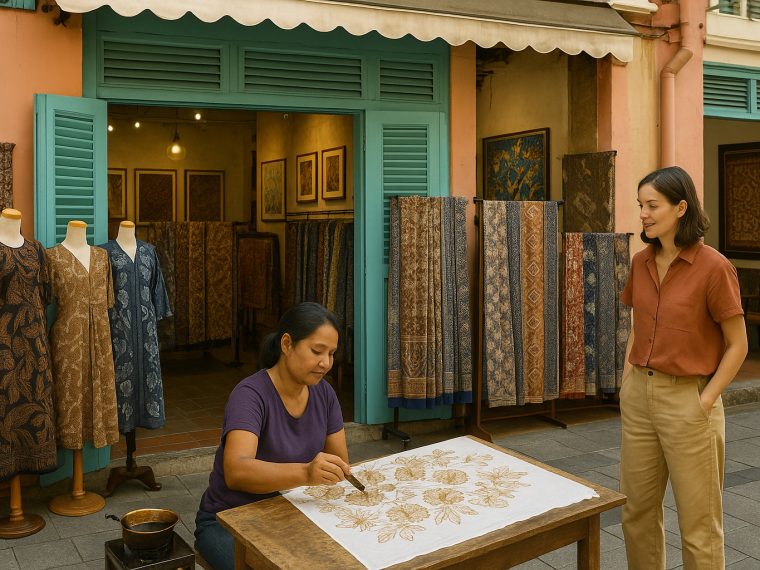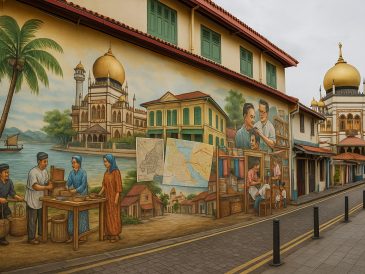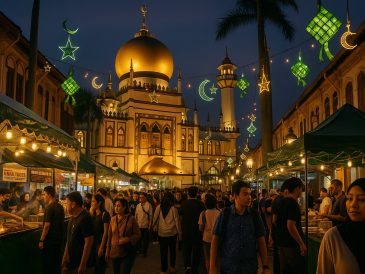Kampong Gelam isn’t just a heritage district—it’s a living canvas. With every corner lined in color, tradition, and texture, few stories run deeper than the story of batik. The Batik History Tour offers a curated path through time, tracing how this traditional textile moved from the hands of traders to the walls of galleries and the bodies of modern fashion lovers. It’s not just about patterns. It’s about identity, transformation, and staying power.
1. From Archipelago to Arab Street
Batik arrived in Singapore in the 19th century with traders from the Malay Archipelago, particularly Java. These early merchants brought with them a wax-resist dyeing technique refined over generations. Kampong Gelam, strategically placed near the waterfront, quickly became a thriving textile hub.
Arab Street emerged as the heartbeat of this trade. Its shophouses once brimmed with bolts of fabric, wax tools, and dye pots. The air carried the scent of hot wax and the energy of barter. Traders dealt in batik not just as fabric but as cultural currency.
Key characteristics of early batik trade in Kampong Gelam:
- Heavy reliance on manual, skill-intensive techniques like batik tulis (hand-drawn).
- Introduction of batik cap (stamped) for quicker production.
- Demand from Malay-Muslim communities for sarongs, shawls, and ceremonial garments.
2. The Role of Heritage Businesses
Though the textile trade landscape has shifted, some family-run businesses have endured. Batik Emporium, established in 1965, stands as a legacy of Kampong Gelam’s commercial roots. Originally operating as a wholesaler, the brand gradually shifted towards retail, creating its own designs.
Their transition reflects the broader transformation of batik in Singapore—from utilitarian cloth to design statement. The Emporium’s fabrics carry the weight of tradition but are shaped with a forward-looking ethos.
3. The Art of Making Batik
Batik isn’t printed. It’s crafted.
The process involves applying melted wax onto cloth using a canting (a pen-like tool) or copper stamp. The fabric is then dyed. Areas covered with wax resist the dye, allowing for complex patterns. The cloth is then boiled to remove the wax, revealing the design.
Core methods of batik making:
- Batik Tulis: Hand-drawn, detailed, labor-intensive.
- Batik Cap: Stamped using metal blocks; faster but less intricate.
This technique demands both precision and patience. The layering of wax and dyes creates nuanced patterns. No two pieces are ever the same.
4. Artistic Reinvention and the Sarkasi Said Legacy
What began as craft has grown into expression. Artists in Singapore reimagined batik beyond garments. Leading this shift was the late Sarkasi Said, Cultural Medallion recipient and pioneer of batik painting.
Sarkasi’s work pushed batik into abstract territory. He used wax and dye like brush and paint, developing bold compositions that broke away from the symmetrical motifs of tradition. His pieces are not just decorative—they tell stories, evoke emotion, and challenge form.
His legacy continues to influence a generation of artists who see batik not as tradition to be preserved, but as a medium to be played with.
5. Contemporary Batik Boutiques and Galleries
Kampong Gelam today is where tradition meets reinterpretation. Walking through the area reveals a new breed of batik shops redefining what the textile can be.
Galeri Tokokita
Founded by Oniatta Effendi, this boutique treats batik as wearable art. With roots in Southeast Asian textile history, Oniatta blends heritage techniques with modern silhouettes. Her work reframes batik for urban wardrobes without diluting its cultural depth.
Kiah’s Gallery
Opened in 2011, Kiah’s focuses on handmade batik pieces that double as both fashion and gallery exhibits. Their custom designs blend traditional motifs with new narratives—subtle, bold, and deeply personal.
What Sets These Spaces Apart:
- Direct partnerships with artisans across Indonesia.
- Emphasis on slow fashion and small-batch production.
- Use of batik in unexpected forms: jackets, dresses, accessories.
6. Interactive Workshops and Hands-On Experiences
Batik in Kampong Gelam isn’t behind glass. It’s in your hands.
Several workshops in the district allow visitors to engage with batik directly. Participants sketch, wax, dye, and boil their own designs under the guidance of seasoned artisans. These sessions often include explanations of motif meanings, from geometric patterns to nature-inspired shapes that speak of fertility, strength, or harmony.
Why they matter:
- They reveal the labor behind a fabric often mistaken for printed cloth.
- They offer cultural context—how motifs connect to rituals, beliefs, and regional identities.
- They create a personal link to an ancient process.
7. Suggested Itinerary: The Batik History Tour
For those looking to experience batik’s full journey, a self-guided walking tour is a perfect way to connect past and present.
Stop 1: Arab Street
Start where the trade began. Observe remaining fabric shops and vintage signage. Some stores still display batik made using traditional cap techniques.
Stop 2: Batik Emporium
Step into a legacy store with decades of history. Speak to the owners if you can—they often have firsthand stories about trade practices, design shifts, and survival strategies.
Stop 3: Malay Heritage Centre
Though currently closed until 2026, past exhibitions here offer deep insight into textile traditions. A virtual tour of the Cerita exhibition is available online.
Stop 4: Galeri Tokokita & Kiah’s Gallery
Compare how two contemporary brands interpret batik. Look for the ways they maintain respect for tradition while pushing into fashion or fine art.
Stop 5: Batik Workshop
Conclude with hands-on learning. Book a batik painting session at any of the artisan-run studios in the area. Walk away with your own creation.
8. Batik as Cultural Identity
Beyond fabric and fashion, batik in Kampong Gelam tells a larger story. It reflects trade routes, family histories, design aesthetics, and cultural shifts. It has moved from functional to expressive, local to global, and remains relevant not because it stayed the same, but because it kept moving.
The Batik History Tour isn’t just about looking. It’s about understanding the hands behind the fabric, the minds that transformed it, and the space that continues to carry it forward.




